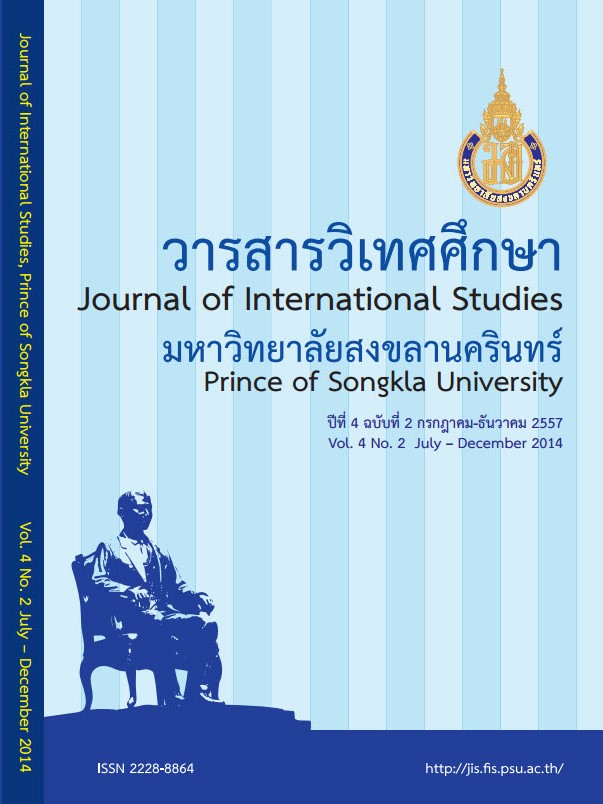Construction Grammar Approach to Teaching ESL Writing in China
Main Article Content
Abstract
The major problems in Chinese students’ ESL writing comprise lexical misuse, grammatical mistakes, collocational errors, lack of consistency, logic and idiomaticity. The past studies mainly focus on the implications and application of construction grammar to ESL acquisition and teaching as a whole, without pertinence to ESL writing in China. The current research aims to clarify the relation between construction and lexical chunks and specifically explore
the applicable means of construction grammar approach to teaching ESL writing in China.
Article Details
Statements and opinions expressed in articles herein are those of the authors and do not necessarily reflect the position of the editors or publisher.
Article, information, text, image, etc. which are published in Journal of International Studies, belong to Journal of International Studies. If anybody or any organization would like to use part or whole of them, they must receive written permission from Journal of International Studies before usage.
References
evidence of recurrent word-combinations. In A.P. Cowie
(ed.), Phraseology: Theory, Analysis and Application (pp.
101-122). Oxford: Oxford University Press.
Bardovi-Harlig, K. (2002). A new starting point? Investigating formulaic
use and input in future expression. Studies in Second
Language Acquisition, 24, 189-198.
Becker, J. (1975). The Phrasal Lexicon. Cambridge Mass: Bolt and
Newman.
Biber D., Conrad S. & Reppen R. (1998). Corpus Linguistics.
Cambridge: Cambridge University Press.
Ellis, N.C. (2005). At the interface: Dynamic interactions of
explicit and implicit language knowledge Studies in
Second Language Acquisition, 27, 305-352.
Goldberg, A. E. (2003). Constructions: A new theoretical approach
to language. Foreign Languages, 3, 1-11.
Goldberg, A. E. (2006). Constructions at Work: The Nature of
Generalization in Language. Oxford: Oxford University Press.
Goldberg, A. E. (1995). Constructions: A Construction Grammar
Approach to Argument Structure. Chicago: Chicago
University Press.
Krashen, S.D. (1982). Principles and Practice in Second Language
Acquisition. New York: Pergamon Press.
Nattinger, J. R. & Jeanette S DeCarrico. (1992). Lexical Phrases and
Language Teaching. London: Oxford University Press.
Tomasello, M. (2003). Constructing a Language: A Usage-Based
Theory of Language Acquisition. Cambridge, MA: Harvard
University Press.
Widdowson, H.G. (1989). Knowledge of language and ability for use.
Applied Linguistics, 10, 12-13.
Wray, A. (2002). Formulaic Language and the Lexicon. Cambridge:
Cambridge University Press.
陈满华。(2009)。构式语法理论对二语教学的启示。
语言教学与研究,(4), 64-70。
陈满华。(2008)。关于构式的范围和类型。解放军
外国语学院学报,(6), 6-11。
戴曼纯。(2012)。语块学习、构式学习与补丁式外
语教学。外语界,(1), 52-60。
桂诗春。(2004)。以语料库为基础的中国学习者英
语失误分析的认知模型。现代外语,(2), 129-139,
216。
郭晓英, 毛红梅。(2010)。语块教学对英语写作能
力影响的实验研究。山东外语教学,(3), 52-59。
李小华, 王立非。(2010)。第二语言习得的构式语
法视角: 构式理论与启示。外语学刊, ( 2 ) ,
107-111。
林正军, 刘永兵。(2012)。构式语法视阈下的英语
语法教学。外语教学理论与实践,(1), 51-57。
秦朝霞。(2009)。国内大学英语写作研究现状及发
展趋势分析。现代外语,(2), 195-204, 220。
孙岩梅, 高江梅。(2011)。概念语法隐喻在大学英
语写作教学中的优势研究。山东外语教学,(2),
73-78。
王立非, 陈香兰。(2009)。语言语块教学与研究在
中国的进展——“首届全国语言语块教学与研
究学术研讨会”综述。外国语(上海外国语大学
学报), (6), 90-94。
王立非, 张大凤。(2006)。国外二语预制语块习得
研究的方法进展与启示。外语与外语教学,(5),
17-21。
谢应光。(2007)。构式语法与英语体义研究。四川
外语学院学报,(1), 96-101。
许先文。(2010)。非英语专业研究生二语写作中的
词块结构类型研究。外语界, 5, 42-47。
杨玉晨。(1999)。英语词汇的“板块性”及其对英
语教学的启示。外语界,(3), 33-34。
于万锁。(2011)。英文写作中的词汇问题与对策。
山东外语教学,(1), 61-66。
袁野。(2010)。构式语法的语言习得观。解放军外
国语学院学报,(1), 35-40, 127。
赵俊峰, 郝晶, 高艳明。(2010)。大学英语写作研
究现状调查。外语学刊,(6), 98-100。


